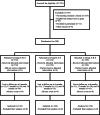Frailty, Fitness, and Quality of Life Outcomes of a Healthy and Productive Aging Program (GrandMove) for Older Adults With Frailty or Prefrailty: Cluster Randomized Controlled Trial
- PMID: 40367490
- PMCID: PMC12094531
- DOI: 10.2196/65636
Frailty, Fitness, and Quality of Life Outcomes of a Healthy and Productive Aging Program (GrandMove) for Older Adults With Frailty or Prefrailty: Cluster Randomized Controlled Trial
Abstract
Background: Exercise interventions can reverse frailty. However, their scalability and sustainability are limited by manpower, which is reducing due to population aging. GrandMove is a program that combines healthy and productive aging strategies to (1) train and employ robust older adults as exercise coaches and (2) improve fitness and motivate the adoption of an exercise habit in older adults with frailty and prefrailty.
Objective: The aim of this study is to examine the effectiveness of GrandMove in improving frailty, fitness, and quality of life in older adults with frailty and prefrailty.
Methods: This cluster randomized controlled trial recruited older adults with frailty and prefrailty (N=390) living in the community. The 18-month exercise program consisted of three 6-month phases of lifestyle education (E), resistance exercise (R), and aerobic exercise (A). Each group of participants was randomized into 3 intervention sequence arms: the E-R-A group, the A-R-E group, and the R-A-E group.
Results: At 6, 12, and 18 months, 346, 305, and 264 participants completed the frailty assessment, respectively. At 6 months, 100 of 346 participants (28.9%) were robust. A-R-E and R-A-E were no better than E-R-A as the active control in addressing frailty over the first 6 months (A-R-E: interaction coefficient 0.07, 95% CI -0.35 to 0.49, P=.68; R-A-E: interaction coefficient -0.02, 95% CI -0.42 to 0.38, P=.90). Compared to lifestyle education, resistance training and aerobic training over the first 6 months were associated with greater improvement in fitness measures of grip strength for the left hand (A-R-E: interaction coefficient 2.99, 95% CI 0.76 to 5.23, P=.009; R-A-E: interaction coefficient 2.21, 95% CI 0.63 to 4.36, P=.04) and right hand (A-R-E: interaction coefficient 3.75, 95% CI 1.54 to 5.97, P=.001; R-A-E: interaction coefficient 2.29, 95% CI 0.16 to 4.42, P=.04) and arm curl test (A-R-E: interaction coefficient 1.42, 95% CI 0.39 to 2.46, P=.007; R-A-E: interaction coefficient 1.11, 95% CI 0.12 to 2.11, P=.03). The sequence of exercise interventions (R-A-E vs A-R-E) did not make a difference in primary outcomes at 12 months, but the R-A-E group showed better quality of life (interaction coefficient 4.50, 95% CI 0.12 to 8.88, P=.008). Improved frailty outcomes were maintained by the end of the study, but the change in overall physical activity level was limited.
Conclusions: Combining healthy and productive aging strategies is a scalable and sustainable way to improve frailty, fitness, and quality of life in older adults with frailty and prefrailty. Different combinations of lifestyle education and physical interventions improved frailty.
Keywords: RCT; active aging; cluster randomized controlled trial; exercising; geriatric; gerontology; older adult; older people; older person; physical activity; physical exercise; postretirement work.
© Jennifer Yee Man Tang, Hao Luo, Michael Tse, Joseph Kwan, Angela Yee Man Leung, Teresa Bik-kwan Tsien Wong, Terry Yat-sang Lum, Gloria Hoi-yan Wong. Originally published in JMIR Aging (https://aging.jmir.org).
Conflict of interest statement
Figures


References
Publication types
MeSH terms
LinkOut - more resources
Full Text Sources
Medical

